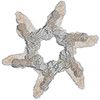| Nov 29, 2024 |
|
|
|
(Nanowerk Spotlight) Extensive work and advancements in blooming field of RNA nanotechnology continuously introduce new design and characterization principles for self-assembling nucleic acid nanoparticles (NANPs), enabling coordinated delivery and release of multiple therapeutic nucleic acids while modulating their immunorecognition. However, the rapid development of NANP technologies leads to increasingly complex structures, thus demanding new experimental pipelines for comprehensive and accurate structural characterization of both current and future designs.
|
|
Techniques such as gel electrophoresis, DLS, AFM, and cryo-EM are routinely used to characterize multistranded NANPs, but each has its limitations. AFM analysis, for example, may provide inaccurate data for large 3D NANPs due to the electrostatic adherence of nucleic acids to the mica surface. Cryo-EM, while simulating a solution environment, does not fully capture the inherent flexibility of NANPs.
|
|
More advanced techniques such as X-ray crystallography and NMR are constrained by static crystalline states and particle size limitations, respectively. Although the combination of these techniques can reveal NANP assembly yields, structural integrities, dispersity, morphology, and sizes, they do not fully capture the solution-state conformational dynamics of NANPs.
|
|
High-resolution scattering techniques like X-ray crystallography can provide atomic-level structural information, but SAXS techniques are better suited for analyzing randomly oriented molecules in solution.
|
|
The latest collaborative work between UNC Charlotte and Brookhaven National Laboratory, published in ACS Applied Materials & Interfaces (“Small-Angle X‑ray Scattering (SAXS) Combined with SAXS-Driven Molecular Dynamics for Structural Analysis of Multistranded RNA Assemblies”), presents an innovative computational framework for modeling multifunctional RNA NANPs.
|
 |
| The experimental workflow of the reported work. (a) Nonfunctional six-stranded RNA NANPs and (b) 12-stranded RNA NANPs with six Dicer substrate RNAs. (c) Schematics depicting the synthesis of NANPs, their characterization, and further analysis by SAXS and SAXS-MD. The formation of tested NANPs was confirmed by (d) DLS and using (e) native-PAGE and AFM. (Image: Reprinted from DOI:10.1021/acsami.4c12397, CC BY 4.0 ) (click on image to enlarge)
|
|
By integrating Small and Wide-Angle X-ray Scattering (SAXS & WAXS) data with data-driven molecular dynamics (SAXS-MD) simulations, we have developed a robust methodology for studying multistranded RNA NANPs in their solution-state environments. SAXS-MD combines experimental SAXS data with molecular dynamics to guide simulations toward biologically meaningful conformations, addressing the limitations of traditional unconstrained MD simulations, which often fail to converge due to the vast conformational space.
|
|
This approach reveals dynamic features such as “breathing” states – critical expansions at key junctions and flexible regions – offering insights into the stability and adaptability of RNA assemblies in solution.
|
|
Powered by high-performance computing (HPC) resources at Brookhaven National Laboratory’s Computational Science Initiative (CSI), this workflow enabled large-scale, parallelized simulations and efficient analysis of SAXS data obtained from the LiX beamline at the National Synchrotron Light Source-II. Iterative SAXS-MD refinements allowed us to explore structural flexibility, inter-strand interactions, and ensemble behaviors that static experimental approaches or unconstrained MD alone cannot resolve.
|
|
By leveraging this methodology, various areas of nucleic acid research and therapeutic nucleic acids can gain insights into the spatial arrangement, intermolecular interactions, and overall conformation of complex structures and NANPs before more detailed assessment of thir biological activities in vivo.
|
|
The predictive capability of the developed approach adds significant value in understanding the behavior and functionality of diverse nanomaterials spanning RNA and DNA nanotechnology, materials science, and biomedicine. This study highlights the power of combining experimental data with advanced simulations, supported by HPC, to advance RNA structural biology and unravel the complex dynamics and functions of biological macromolecules.
|
|
Provided by Afonin Lab, Department of Chemistry, The University of North Carolina at Charlotte
|
|
|


